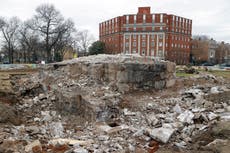Court rules city can take down statue of Confederate general AP Hill
Abe Asher
The city of Richmond, Virginia, former capital of the Confederacy, can tear down its final remaining Confederate statue, a judge has said.
Circuit Court Judge David Eugene Cheek Sr ruled on Tuesday that the city can remove a statue of AP Hill, a Confederate general killed during the Third Battle of Petersburg that currently sits at an intersection of Laburnum Avenue and Hermitage Road.
The city has wanted to move the statue to its Black History Museum, but members of Hill’s family objected — arguing that the city didn’t have the authority to move the statue because it sits on the area where the general was buried and thus constitutes a burial site.
In court, the city argued that the statue actually constitutes a war memorial and falls under its jurisdiction. Mr Cheek, in a ruling first reported by CNN, agreed.
“We’re gratified by Judge Cheek’s ruling,” Richmond Mayor Levar Stoney told the network in a statement. “This is the last stand for the Lost Cause in our city.”
Recommended

Richmond seeks to move last city-owned Confederate monument


Pedestal where Lee statue stood in Va. capital fully removed
It’s been a long road to this moment for Richmond, which is now a heavily Democratic and majority non-white city and has been roiled by racial justice protests in recent years. The city began moving to take down its Confederate statues in earnest in 2017 following the deadly Unite the Right far right and neo-Nazi rally in nearby Charlottesville, and those efforts gained momentum in the aftermath of the murder of George Floyd in the spring and summer of 2020.
Richmond was long home to a number of notable Confederate monuments, many of which lined Monument Avenue in one of the city’s historic districts. Perhaps the most visible of those monuments, depiciting Confederate general Robert E Lee, was heavily vandalised during the summer of 2020 and removed last fall.
Monuments to Confederates J.E.B. Stuart, Stonewall Jackson, Matthew Fontaine Mauryand and Jefferson Davis that long stood on the avenue were also toppled or removed in the last two-plus years.
Scott Braxton Puryear, an attorney who represented the plantiffs in the case, told CNN that they had no comment on the ruling.
“We look forward to a successful conclusion of the legal process, which will allow us to relocate Hill’s remains, remove and transfer the statue to the Black History Museum and, importantly, improve traffic safety at the intersection of Hermitage and Laburnum,” Mr Stoney, who was first elected mayor in 2016, said in his statement.
It’s been a long road to this moment for Richmond, which is now a heavily Democratic and majority non-white city and has been roiled by racial justice protests in recent years. The city began moving to take down its Confederate statues in earnest in 2017 following the deadly Unite the Right far right and neo-Nazi rally in nearby Charlottesville, and those efforts gained momentum in the aftermath of the murder of George Floyd in the spring and summer of 2020.
Richmond was long home to a number of notable Confederate monuments, many of which lined Monument Avenue in one of the city’s historic districts. Perhaps the most visible of those monuments, depiciting Confederate general Robert E Lee, was heavily vandalised during the summer of 2020 and removed last fall.
Monuments to Confederates J.E.B. Stuart, Stonewall Jackson, Matthew Fontaine Mauryand and Jefferson Davis that long stood on the avenue were also toppled or removed in the last two-plus years.
Scott Braxton Puryear, an attorney who represented the plantiffs in the case, told CNN that they had no comment on the ruling.
“We look forward to a successful conclusion of the legal process, which will allow us to relocate Hill’s remains, remove and transfer the statue to the Black History Museum and, importantly, improve traffic safety at the intersection of Hermitage and Laburnum,” Mr Stoney, who was first elected mayor in 2016, said in his statement.
No comments:
Post a Comment